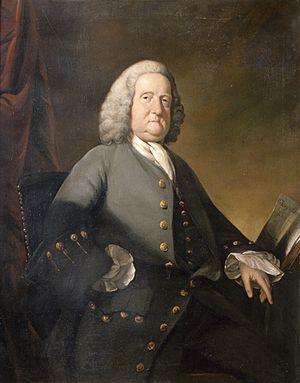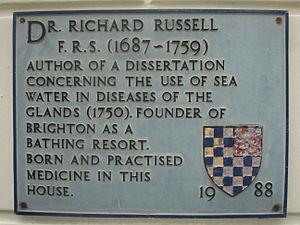Richard Russell (doctor) facts for kids

Richard Russell (born 1687 – died 1759) was a British doctor in the 1700s. He believed that using seawater could help people get healthy. His method involved bathing in the sea and sometimes drinking seawater. Today, a similar idea is called thalassotherapy, though people don't usually drink seawater anymore.
Contents
Early Life and Family
Richard Russell was born in 1687. His father, Nathaniel Russell, was a surgeon in Lewes, a town in Sussex, England. Richard was the oldest of seven children.
Medical Career Begins
Dr. Russell started his medical practice in Lewes in 1725. He later bought some land in a place called Ditchling. This land was passed down to his son, William Russell, after Dr. Russell's death.
Brighton and Seawater Therapy
Around 1747, Dr. Russell moved to Brighton. He wanted to test his ideas about how seawater could help people. In 1750, he wrote a book in Latin called De Tabe Glandulari. In this book, he suggested that seawater could help with swollen glands. The book was translated into English in 1752 and became very popular. It was one of the first books to say that bathing in and drinking seawater could make people healthier.
Dr. Russell especially recommended the seawater near Brighton. He said it was better than the water from inland spas (places with natural springs). His ideas became very popular in England and other countries. Even though people argued about the best ways to use seawater, most agreed it was helpful.
By 1753, so many people wanted his treatments that he moved his main office to Brighton. He bought a piece of land for £40, which was a lot of money back then. This is where the Royal Albion Hotel stands today. His new house was the biggest in Brighton at the time. It had rooms for his patients and for himself. The back of the house opened right onto the beach.
Dr. Russell's work helped make visiting the seaside very popular in the 1700s. A plaque on the Royal Albion Hotel says, "If you seek his monument, look around." This means that the town of Brighton itself is his lasting legacy.
After Dr. Russell died in 1759, his house was rented out to visitors. One famous visitor was the Duke of Cumberland, who was the brother of King George III. Later, in 1783, the Prince of Wales (who later became the Prince Regent) visited his uncle there. The Prince Regent loved Brighton and visited often for the next 40 years. His visits helped the small fishing village of Brighthelmston grow into the famous town of Brighton.
Dr. Russell was also chosen to be a Fellow of the Royal Society in 1752. This is a group of important scientists.
Burial and Legacy
Dr. Richard Russell was buried in South Malling, near Lewes. His oldest son, William, inherited his property. To get the inheritance, William had to change his last name to Kempe, which was his mother's family name. Dr. Russell's medical practice in Brighton was taken over by another doctor named Anthony Relhan.


